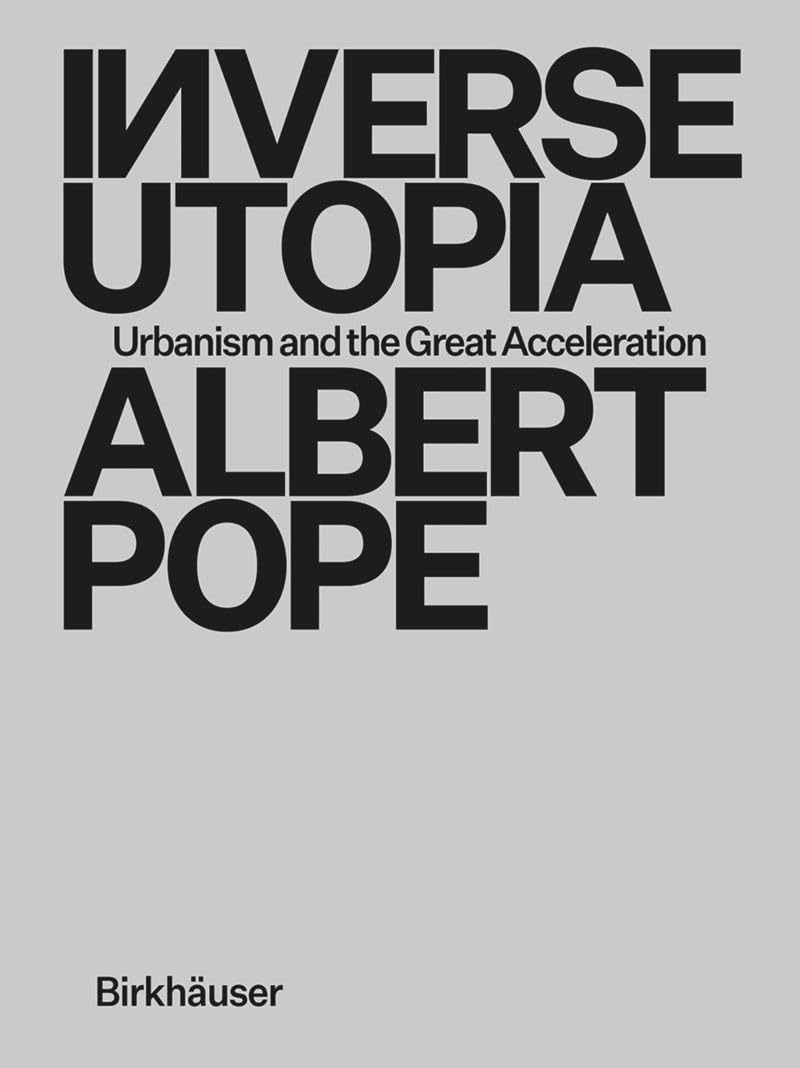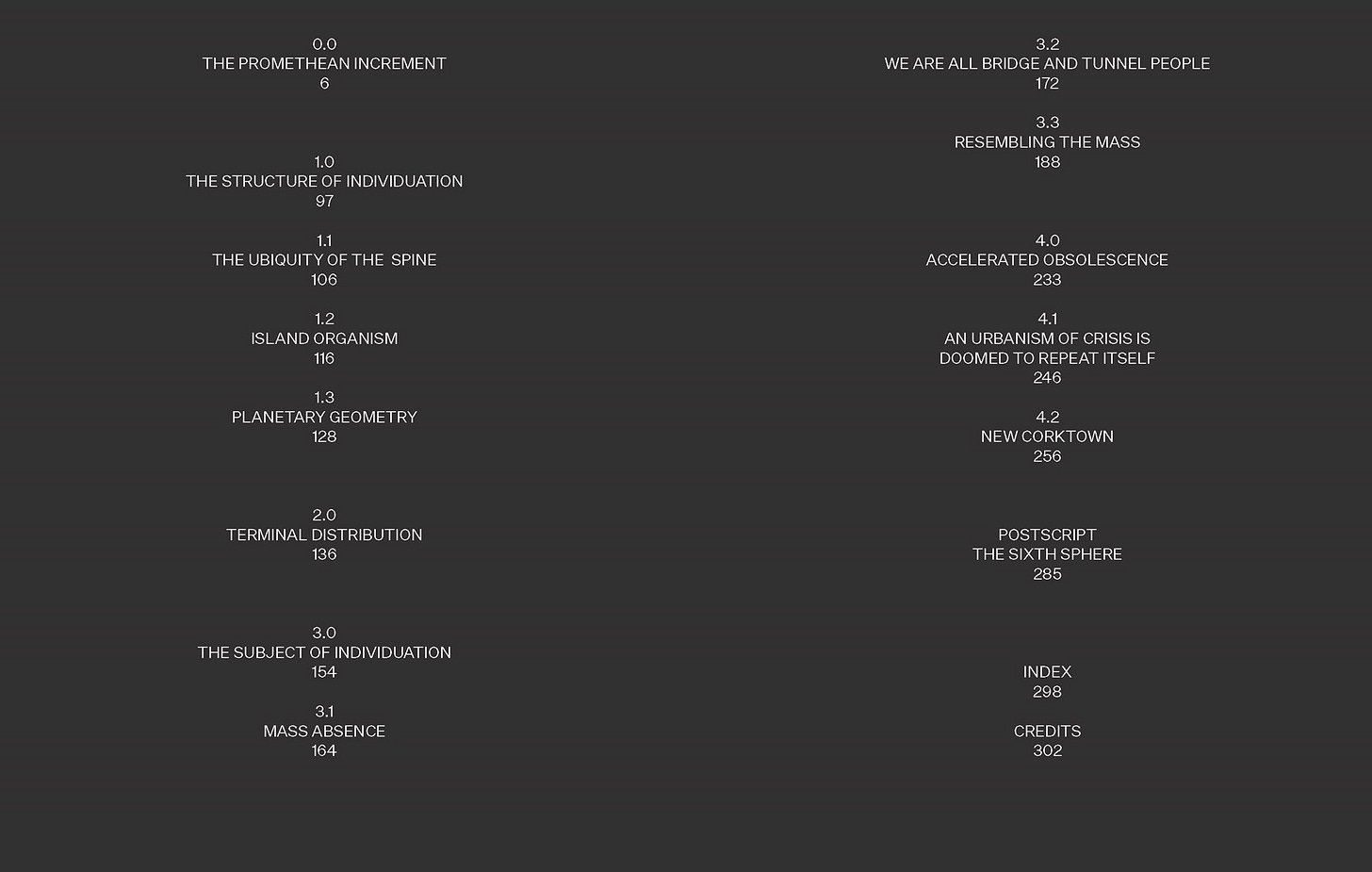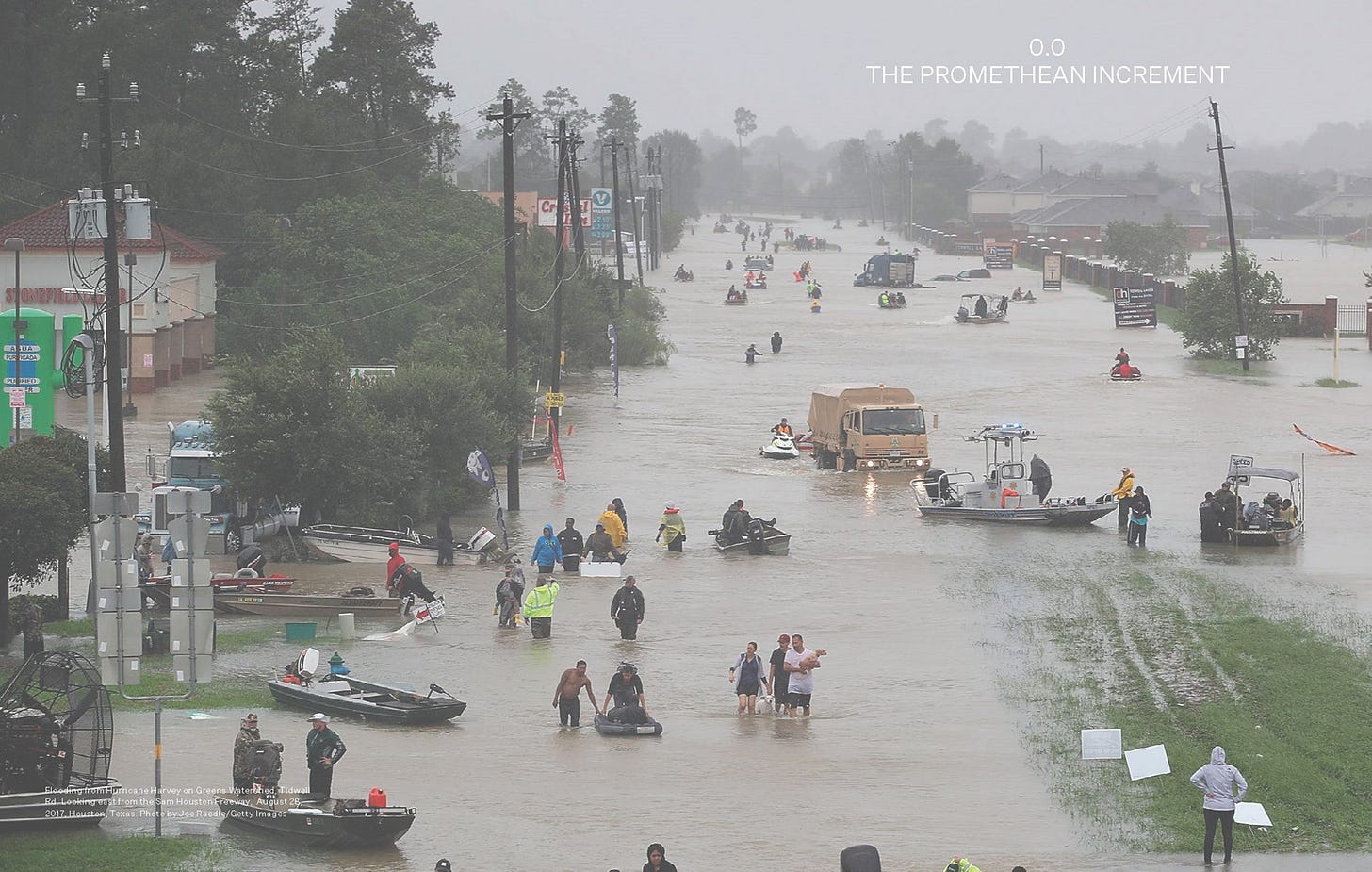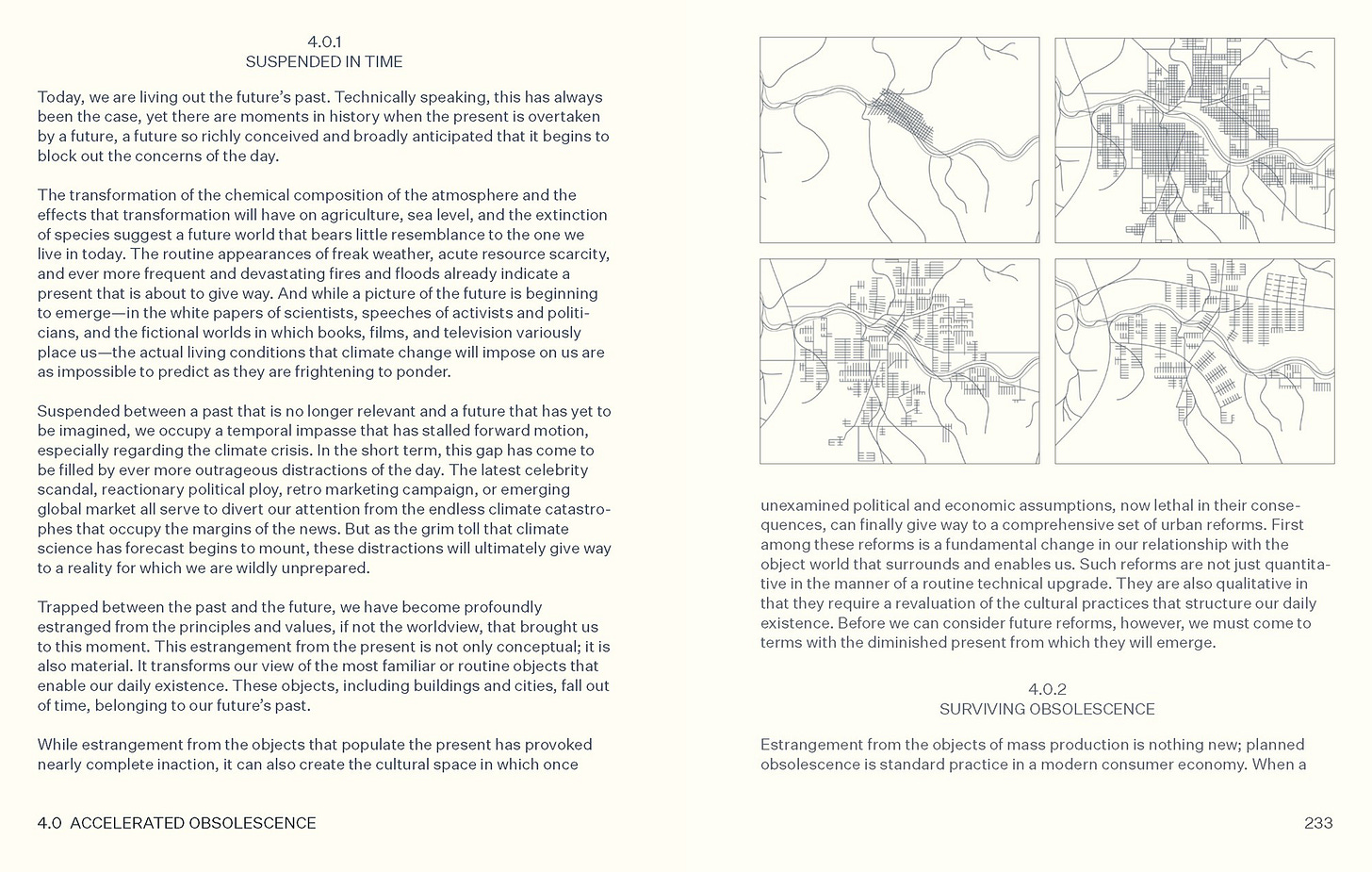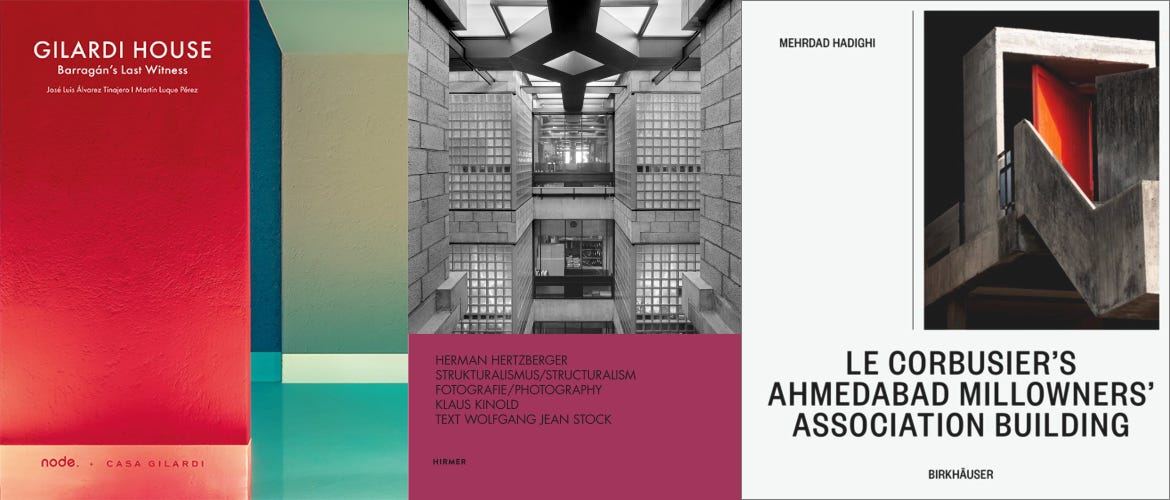This newsletter for the week of June 30 looks at the latest book by Rice University professor Albert Pope, Inverse Utopia: Urbanism and the Great Acceleration, which was published by Birkhäuser last fall. Pope’s seminal book Ladders, published nearly thirty years ago, is at the bottom of the newsletter, and in between are the usual headlines and new releases. Happy reading!
Book of the Week:
Inverse Utopia: Urbanism and the Great Acceleration, by Albert Pope (Buy from Birkhäuser / from Amazon / from Bookshop)
Nearly thirty years ago, Rice University professor Albert Pope published Ladders, a critical analysis of the shift from gridded cities in the United States to auto-centric, cul-de-sac suburbs, from the centrifugal city to the centripetal city. Pope’s seminal book looked at how the traditional gridded city was infiltrated by suburban forms: highways, atrium hotels, convention centers, and so on. Although Pope seemed to side with grids being more effective for dense cities, the strongest argument in his 1997 book—republished in 2015—was saying that architects and planners cannot propose meaningful fixes for, or interventions in, the contemporary city without understanding its nature, without understanding both types of urban conditions. (See bottom for a little more about Ladders.) Inverse Utopia takes a similar approach to Ladders but also upends his earlier thesis by arguing that the cul-de-sac, or spine (not ladder) city offers the best approach forward for humanity to address climate change at a meaningful scale.
Pope begins the book with a quote by Günther Anders that starts to explain the title of the book and its thesis. It reads, in part: “…we are inverted Utopians: whereas Utopians are unable to make the things they imagine, we are unable to imagine the things we make.” A bit vague ahead of the table of contents, Anders’s words are clearer when they are reiterated in the book’s concluding chapter, some 285 pages later. Basically, our inability to imagine the things we make is tied to the environmental impacts of our actions and creations, such that humans have been able to create cars, factories, plastic bags, the internet, and so on, but the entity formed by them—the technosphere—is too big for people to comprehend, control through political or other means, or otherwise reign in its adverse effects. What nearly every human on the planet depends on—the technosphere’s flow of bits and bytes, energy, food, goods, people, etc.—is killing us and the planet, but we are unable to meet the crises with solutions that are bigger than ourselves, that are more substantial than using reusable totes, switching to LED lamps, or walking instead of driving. For Pope, adaptive reuse and other single-building approaches to sustainability are as insufficient as the choices we make in our daily lives. He wants architects and urban designers to know they can address the climate crisis, but they need to think big—at the scale of the city and its suburbs.
Humans have bodies, and as such first hand experiences color our actions more than distant or virtual experiences. In the realm of climate change and its impacts, people in New York City were impacted by Sandy in October 2012, New Orleans residents by Katrina in 2005, Angelenos by the Eaton and Palisades fires earlier this year, and for Pope and other residents of Houston it was the flooding from Hurricane Harvey in August 2017. The first, zero chapter, “The Promethean Increment,” lays out the book-length argument that was born from essays Pope wrote for Log and other publications in the years since Ladders, but it also includes a proposal: the Westbury Floodplain Reclamation, a project by Present Future, the master’s program at Rice that Pope heads. While it focuses on Westbury, a trapezoidal patch of southwestern Houston, the project embodies principles that could apply to any and every city in the United States and potentially beyond.
One is embracing the two types of spine developments of the contemporary city—the Garden City and the Radiant City—through what is almost a fusion of them into denser, low-carbon constructions. Second is the thinning out of (sub)urban areas to introduce more nature and wildlife, and to restrict buildings to sites that won’t flood or otherwise be impacted by the effects of climate change. And third is developing urban scenarios that evolve over time, rather than developing static masterplans that depend on final visions and all too often fall back on traditional urban forms. The project images in the chapter depict things like modern slabs alongside abundant natural corridors. While not wholly convincing on their own, they combine with the text to make a strong argument for an urbanism that actually aspires to integrate humans with nature, not position them above it or outside of it.
Given that Pope’s new book is an assemblage of previously edited essays, at least one chapter pulled from Ladders, and a couple projects from Present Future, readers will find some overlap as they move their way through Inverse Utopia; this also arises from Pope’s writing, which seems to swirl around a theme, a bit like Hurricane Harvey swirling over Houston for days in August 2017. Some topics that come up more than once are two plans by OMA, one derided for its recombination of traditional urban forms (Waterfront City) and one praised for elevating space over object (Melun-Sénart); Peter Sloterdijk’s Spheres series, especially his idea of “explication” and “foams”; and postwar urban plans by Ludwig Hilberseimer, many of them from The Nature of Cities, published in 1955. Hilberseimer’s projects, including those for Rockford, Illinois, and Marquette Park in Chicago, serve as something of a template for Pope, who appreciates how Hilberseimer diagrammed the cities or districts over time and foreshadowed how grids would be supplanted by spine-based, cul-de-sac urbanism.
Foremost, though, is Pope’s argument that Hilberseimer and other modernists were experimenting, not proposing final solutions, and the postmodernist reaction—of embracing the traditional city—derailed the continuation of experiments in both architecture and urbanism. We can’t know, of course, but if subsequent generations were able to continue the work of Hilberseimer and other modernists, the suburbs would now look more like the Westbury Floodplain Reclamation project than the reality we know far too well. All we can say for sure is that implementing something at the scale Pope imagines is that much harder, given the way suburban lifestyles are entrenched in the American way of life. But if we are going to take the impacts of climate change seriously, and not ignore it as reactionary politicians do today, then cities and suburbs—especially the suburbs—have to be reshaped dramatically. Architects and urbanists interested in that task should read Inverse Utopia.
Books Released This Week:
(In the United States; a curated list)
1960s University Buildings: The Golden Age of British Modern Architecture, by John Barr (Buy from Lund Humphries / from Amazon / from Bookshop) — “Somehow, the university buildings of the 1960s seemed to represent the cutting edge of modern architecture in the UK. This book provides the first critical analysis and overview of these buildings, designed by some of the leading British architects of the period.”
Value of Design: Creating Agency Through Data-Driven Insights, by Andrea Chegut, Minkoo Kang, Helena Rong and Juncheng “Tony” Yang (Buy from ORO Editions / from Amazon / from Bookshop) — “This book acts as a platform to bridge the gap between design and finance, using empirical research to dissect design into measurable features through data-driven methodologies, with New York City serving as the experimental research site.”
Modernist New York Map: Guide to 20th Century Modern Architecture in New York City, by Allison C. Meier (Buy from Blue Crow Media / from Amazon / from Bookshop) — “Explore extraordinary examples of Modernist architecture built across New York City with Blue Crow Media’s latest guide map. Featuring over fifty buildings, this two-sided guide includes original photography, building details and an introduction.”
Previously announced titles being released this week:
Gilardi House: Barragan’s Last Witness, by José Luis Alvarez Tinajero (Buy from Actar Publishers / from Amazon / from Bookshop) — “This masterpiece was the last built project of Pritzker Prize winner Luis Barragan’s prolific career. Gilardi House aims to disseminate the complete history of the project, from the first sketch to its construction.” (Originally announced in February.)
Hermann Hertzberger: Structuralism, by Klaus Kinold, with text by Wolfgang Jean Stock (Buy from University of Chicago Press [US distributor for Hirmer Publishers] / from Amazon / from Bookshop) — “The award-winning photographer Klaus Kinold documents buildings designed by Hermann Hertzberger, one of the innovators of Structuralist architecture.” (Originally announced in April.)
Le Corbusier’s Millowners Association Building: Between System and Improvisation, by Mehrdad Hadighi (Buy from Birkhäuser / from Amazon / from Bookshop) — “The Millowners' Association Building in Ahmedabad, designed by Le Corbusier and completed in 1954, has rarely been published, but is nevertheless considered an important milestone in the architect's work. In addition to numerous scaled drawings, newly produced models clarify the most important design aspects of the building.” (Originally announced in May.)
Full disclosure: As an Amazon Associate, AbeBooks Affiliate, and Bookshop.org Affiliate, I earn commissions from qualifying purchases made via any relevant links above and below.
Book News:
Boing Boing gives a peek inside The Great American Retro Road Trip (Artisan Books), by Rolando Pujol, calling it “a fantastic book that meticulously, voluminously, and joyously chronicles the beauty of the commercial art and architecture of the American roadside.”
Glasgow From Above, by architect and academic Rosalie Menon with drone photography by Alistair Leith, “blends architectural commentary with striking aerial photography,” per Project Scotland, “and offers a fresh perspective on how the city’s built environment has transformed over the past 25 years.”
Congratulations to journalist Jenna McKnight on earning her PhD in Design and Planning from the College of Architecture and Planning at the University of Colorado Denver. I’m hoping her intriguing dissertation, Beyond the Traditional Gatekeeper: Architecture and Photography in the Age of Instagram, finds wider publication in the near future.
BK Expo: Architects disseminate opened at TU Delft on June 23; it is on display until September 1, 2025. Curated by Dean Dick van Gameren, Javier Arpa Fernández and Jesse Verdoes , the exhibition displays works that “reveal that architecture is not only practiced through building, but also through storytelling.”
In a review I edited for World-Architects, Madeline Beach Carey reviews The Summer House, the debut novel by Masashi Matsuie, which follows a small team of architects one summer as they set out to design the National Library of Modern Literature.
Naomi Stead briefly reviews Australian House: The Robin Boyd Award, a new book that “gathers all the winners since the award’s inception in 1981 into a tome with decidedly more heft – both literal and figurative – than your average real-estate lookbook.”
Graham McKay just wrapped up his translation, from Japanese to English, of Riken Yamamoto’s The Space of Power vs. The Power of Space, done in dozens of installments on his blog between March 2024 and June 2025 (scroll down the linked page to see the installments).
From the Archives:
I reviewed Albert Pope’s seminal Ladders—first published in 1997 (cover pictured here), then reprinted by Princeton Architectural Press in 2015—on my blog back in 2019, spurred by the publication of Joan Busquets' Urban Grids, which I also reviewed. Here’s part of what I wrote about Ladders:
Pope defines two types of (American) cities in Ladders: the centrifugal city and the centripetal city. The first is the gridded, expansive “open city” that is often associated with 19th century cities but has its roots in even older cities. The centripetal city, on the other hand, is the postwar, auto-centric anti-grid and the places it created: suburban enclaves disconnected from the cities and inner-city developments also violating the grid. Pope calls these cities and developments “ladders,” because they have one route in and out, not the multiple routes afforded by the grid; and he called the developments created by the grid's implosion “ellipses.” Once the grid is ignored, as in suburbs or garden cities that ring a city but are disconnected from it, the centrifugal city suffers and the only recourse is for the centripetal city to infuse or infect the ailing city. Hence public housing on superblocks, and the massive convention centers, stadiums, atrium hotels, and other corporate complexes that are fitted into the grid but are otherwise closed off from it through functional homogeneity and the centripetal highways that cut up the city.
It's a very clear thesis, and it's one that runs parallel to other critiques of modern urban planning and the suburbs. But with its focus on the grid—the armature that enables the traditional city to work so well—Pope ekes out a niche for his argument. Pope's book argues that architects and planners cannot propose meaningful fixes for, or interventions in, the contemporary city without understanding its nature; Ladders is one of the most effective ways I've come across for them to achieve this.
A note on the book's layout and graphic design: Just as Pope explains the erosion of the centrifugal grid from the forces of the centripetal city, the grid that serves as the background for the right-hand pages (throughout the book, not just at the chapter intros, as shown here) slowly erodes and is then washed away entirely by the conclusion. It's an intriguing, yet subtle way of expressing the book's argument.
Thank you for subscribing to A Weekly Dose of Architecture Books. If you have any comments or questions, or if you have your own book that you want to see in this newsletter, please respond to this email, or comment below if you’re reading this online. All content is freely available, but paid subscriptions that enable this newsletter to continue are welcome — thank you!
— John Hill




